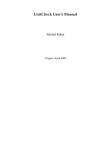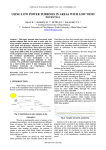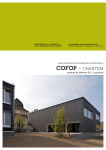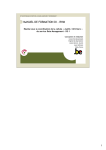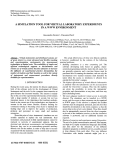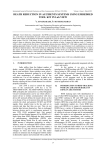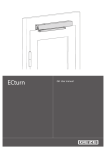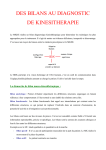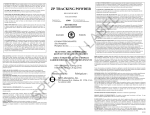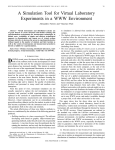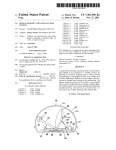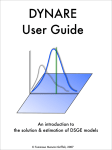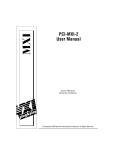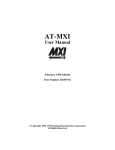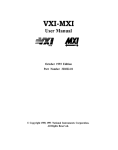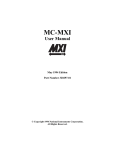Download full-paper
Transcript
Journal of ELECTRICAL ENGINEERING, VOL. 55, NO. 1-2, 2004, 50–56 REVIEWS - LETTERS - REPORTS VIRTUAL INSTRUMENTATION AND DISTRIBUTED MEASUREMENT SYSTEMS Viktor Smieško — Karol Kováč ∗ The development and use of programmable measurement systems have been widely explored. The possibility of modifying the measurement procedure simply by changing the algorithm executed by the computer-based architecture without replacing the hardware components makes the experimental activity easier. Virtual measurement systems have been introduced to simplify the design, implementation and use of programmable measurement systems by adopting a visual interface. Networking has also been introduced successfully in measurement to interconnect different instruments and data processing sites into a distributed measurement system (DMS). Industries that develop and use DMS are migrating away from proprietary hardware and software platforms in favour of open systems and standardized approaches. K e y w o r d s: virtual instrumentation, distributed measurement system, remote and networked measurement, interconnect buses. 1 INTRODUCTION For many years electronic instruments have been easily identified products. Although they ranged in size and functionality, they all tended to be box-shaped objects with a control panel and a display. Stand-alone electronic instruments are very powerful, expensive and designed to perform one or more specific tasks defined by the vendor. However, the user generally cannot extend or customize them. The knobs and buttons on the instrument, the built-in circuitry, and the functions available to the user, all of these are specific to the nature of the instrument. In addition, special technology and costly components must be developed to build these instruments, making them very expensive and hard to adapt. Widespread adoption of the PC over the past twenty years has given rise to a new way for scientists and engineers to measure and automate the world around them. One major development resulting from the ubiquity of the PC is the concept of virtual instrumentation. A virtual instrument consists of an industry-standard computer or workstation equipped with off-the-shelf application software, cost-effective hardware such as plug-in boards, and driver software — which together perform the functions of traditional instruments. Today virtual instrumentation is coming of age, with engineers and scientists using virtual instruments in literally hundreds of thousands of applications around the globe, resulting in faster application development, higher quality products and lower costs. Virtual instruments represent a fundamental shift from traditional hardware-centred instrumentation systems towards software-centred systems that exploit the computing power, productivity, display and connectivity capabilities of popular desktop computers and workstations. Although PC and integrated circuit technologies experienced significant advances in the past two decades, it is the software that makes possible building virtual instruments on this foundation. Engineers and scientists are no longer limited by traditional fixed-function instruments. Now they can build measurement and automation systems that suit exactly their specific needs. 2 THE CONCEPTION OF VIRTUAL INSTRUMENT Usually instrumentation manufacturers provide specific functions to given architecture and fixed interfaces for measuring devices, and thus limit the application domain of these devices. In actual use much time is required for adjusting the measuring range and for saving and documenting the results. The advent of microprocessors in the measurement and instrumentation fields produced rapid modifications of measuring device technology, soon followed by the appearance of computer-based measurement techniques. Conceptual model of early-computerized instrumentation is given in Fig. 1. A single user controls the system, which runs exclusively on a piece of hardware. There is a single control structure, which is formed by the combination of the user and the program that controls the multiple devices attached to the instrumentation bus. The main challenges are the device coupling and the programming models. The measurement consists of three parts, as shown in Fig. 2, acquisition of measurement data or signals, conditioning and processing of analysis of measurement signals and presentation of data. The concept of virtual instrument is frequently used in industrial measurement practice, but not always with precisely the same meaning. For some people, virtual instruments are based on standard computers and represent systems for storage, processing and presentation of ∗ Department of Measurement, Slovak University of Technology,Ilkovičova 3, 812 19 Bratislava, Slovakia c 2004 FEI STU ISSN 1335-3632 51 Journal of ELECTRICAL ENGINEERING, VOL. 55, NO. 1-2, 2004 PROGRAM USER DEVICE DRIV ER INSTRUMENTATION BUS DEVICE 1 DEVICE 2 DEVICE n PROCESS Fig. 1. Conceptual model of early computerized instrumentation SIGNALS ACQUISITION AND INSTRUMENT CONTROL PRESENTATION PROCESSING OR ANALYSIS Fig. 2. The diagram of measurement process ADDED HARDWARE SIGNAL GENERATION P C ADDED SOFTWARE DATA PROCESSING DATA ACQUISITION DATA PRESENTATION Fig. 3. The general conception of virtual instrument measurement data. For others, a virtual instrument is a computer equipped with software for a variety of uses including drivers for various peripherals, as well as analogue to digital and digital to analogue converters, representing an alternative to expensive conventional instruments with analogue displays and electronics. Both views are more or less correct. Acquisition of data by a computer can be achieved in various ways and for this reason the understanding of the architecture of the measuring instrument becomes important. A virtual instrument can be defined as an integration of sensors by a PC equipped with specific data acquisition hardware and software to permit measurement data acquisition, processing and display. A virtual instrument can replace the traditional front panel equipped with buttons and display by a virtual front panel on a PC monitor. Virtual instruments are a means of integration of the display, control and centralization of complex measurement systems. Industrial instrumentation applications, however, require high rates, long distances, and multi- vendor instrument connectivity based on open industrial network protocols. In order to construct a virtual instrument it is necessary to combine the hardware and software elements which should perform data acquisition and control, data processing and data presentation in a different way to take maximum advantage of the PC. It seems that in the future the restrictions of instruments will move more and more from hardware. Such a general conception of virtual instrumentation is presented in Fig. 3. The vendor of virtual instrument can use the serial communication based on RS-232 standard or the parallel communication based on GPIB standard (known also as HP-IB, IEEE 488.1-2 or IEC 625.1-2), PC bus, or VXIbus (VME eXtension for Instrumentation). The main categories of virtual instruments: a) Graphical front panel on the computer screen to control the modules or instruments a1) controlled module is plug-in DAQ board, a2) controlled instrument is based on GP-IB board, a3) controlled instrument is connected via serial port, a4) controlled instrument is VXI-board (or system). b) Graphical front panel with no physical instruments at all connected to the computer. Instead, the computer acquires and analyses the data from files or from other computers on a network, or it may even calculate its data mathematically to simulate a physical process or event rather than acquiring actual real world data. To the PC connections according to point a) the following process measuring devices are attached: – Sensors – GP-IB instruments – Serial instruments – VXI instruments This structure is a result of international standardization allowing more freedom in using boards and instruments from various manufactures. The main representative features of virtual instruments describing their functionality are following: – Enhancing traditional instrument functionality with computers; – Opening the architecture of instruments; – Widespread recognition and adoption of virtual instrument software development frameworks. 3 BASIC COMPONENTS OF VIRTUAL INSTRUMENTS The basic components of all virtual instruments include a computer and a display, the virtual instrument software, a bus structure (that connects the computer with the instrument hardware) and the instrument hardware. 52 V. Smieško — K. Kováč: VIRTUAL INSTRUMENTATION AND DISTRIBUTED MEASUREMENT SYSTEMS Driver level software PC DAQ BOARD GP - IB BOARD SENSORS SERIAL PORT MXI BOARD „SERIAL“ INSTRUMENTS GP - IB INSTRUMENTS VXI INSTRUMENTS PROCES Fig. 4. Structure of the PC-based instrumentation hardware One of the most important components in measurement systems today is the device driver software. Device drivers perform the actual communication and control of the instrument hardware in the system. They provide a medium-level easy-to-use programming model that enables complete access to complex measurement capabilities of the instrument. In the past programmers spent a significant amount of time writing this software from scratch for each instrument of the system. Today, instrument drivers are delivered as modular, off-the-shelf components to be used in application programs. Several leading companies formed (in 1988) the Interchangeable Virtual Instrument (IVI) Foundation. The IVI Foundation was formed to establish formal standards for instrument drivers and to address the limitations of the former approaches. 3.1 Computer and Display The computer and the display are the heart of virtual instrument systems. These systems are typically based on a personal computer or workstation with a highresolution monitor, a keyboard, and a mouse. It is important for the chosen computer to meet the system requirements specified by the instrumentation software packages. Rapid technological advancements of PC technology have greatly enhanced virtual instrumentation. Moving from DOS to Windows gave to PC users the graphical user interface and made 32-bit software available for building virtual instruments. The advances in processor performance supplied the power needed to bring new applications within the scope of virtual instrumentation. Faster bus architectures (such as PCI) have eliminated the traditional data transfer bottleneck of older buses (ISA). The future of virtual instrumentation is tightly coupled with PC technology. 3.2 Software If the computer is the heart of the virtual instrument systems, the software is their brain. The software uniquely defines the functionality and personality of the virtual instrument system. Most software is designed to run on industry standard operating systems on personal computers and workstations. Software implemented can be divided into several levels, which can be described in a hierarchical order. Register level software Register-level software requires the knowledge of inner register structure of the device (DAQ board, RS 232 instrument, GP-IB instrument or VXI module) for entering the bit combination taken from the instruction manual in order to program measurement functions of the device. It is the hardest way in programming. The resulting program is strongly hardware dependent and it is rarely executable on systems with different hardware. High-level tool software Currently the most popular way of programming is based on the high-level tool software. With easy-to-use integrated development tools, design engineers can quickly create, configure and display measurements in a userfriendly form, during product design, and verification. The most known, popular tools are as follows: • LabVIEW (Laboratory Virtual Instrument Engineering Workbench) — is a highly productive graphical programming language for building data acquisition and instrumentation systems. To specify the system functionality one intuitively assembles block diagrams — a natural design notation for engineers. Its tight integration with measurement hardware facilities rapid development of data acquisition, analysis and presentation of solutions. • LabWindows/CVI (C for Virtual Instrumentation) — is a Windows based, interactive ANSI C programming environment designed for building virtual instrumentation applications. It delivers a drag-and-drop editor for building user interfaces, a complete ANSI C environment for building test program logic, and a collection of automated code generation tools, as well as utilities for building automated test systems and monitoring applications of laboratory experiments. The main power of CVI lies in the set of libraries. • HP VEE (Hewlett-Packard’s Visual Engineering Environment) — allows graphical programming for instrumentation applications. It is a kind of Visual Engineering Environment, an iconic programming language for solving engineering problems. It also provides an opportunity to gather, analyze and display data without conventional (text-based) programming. • TestPoint — is a Windows based object-oriented software package that contains extensive GPIB instrument and DAQ board support. It contains a novel state-ofthe art user interface that is easy to use. Objects, called “stocks” are selected and dragged with a mouse to a work Journal of ELECTRICAL ENGINEERING, VOL. 55, NO. 1-2, 2004 area (panel). Logic flow is easily established with a point and drag action list. TestPoint takes advantage of every Microsoft Windows features. • Measurement Studio — is a measurement tool for data acquisition, analysis, visualization and Internet connectivity. This development tool helps you build your test system by integrating into your existing Microsoft compiler. Measurement Studio provides a collection of controls and classes designed for building virtual instrumentation systems inside Visual Basic or Visual C++. With Measurement Studio you can configure plug-in data acquisition boards, GPIB instruments, and serial devices from property pages without writing any code. With user interface components you can configure real-time 2D and 3D graphs, knobs, meters, gauges, dials, tanks, thermometers, binary switches, and LEDs. With powerful Internet components, you can share live measurement data among applications via the Internet. SCPI — Standard commands for programmable instruments SCPI is not a software tool as are former systems, but it is an effective aid enabling easy standardised control of programmable instruments. SCPI decreases development time and increases a readability of test programs. SCPI provides an easy understandable command set, guarantees a well-defined instrument behaviour under all conditions, which prevents unexpected instrument behaviour. Although IEEE 488.2 is used as basis of SCPI, it defines programming commands that we can use with any type of hardware or communication link. It has an open structure. The SCPI Consortium continues in adding commands and functionality to the SCPI standard. Real-time and embedded control has been long the domain of specialised programs. Advances in industrystandard technologies including more reliable operating systems, more powerful processors and computer-based real-time engineering tools are introducing new levels of control and determinism to virtual instrumentation. This presents new opportunities for scientists to take on increasingly sophisticated real-time and embedded development. Software scales across development on the PC into development in real-time and embedded applications. Scientists and engineers can move into new application areas without a steep learning curve because the software itself evolves to incorporate emerging computer technologies. 3.3 Interconnect Buses Four types of interconnect buses dominate the industry: the serial connection (serial port), the GPIB, the PC bus and VXI bus. Serial port. Serial communication based on RS-232 standard is the simplest way of using a computer in measurement applications and control of instruments. Serial communication is readily available via the serial port of any PC and it is limited in data transmission rate and distance (up to 19.2 Kbytes/sec, recently 115 Kbytes/sec, 53 and 15 m) and it allows only one device to be connected to a PC. GPIB. It was the first industry standard bus for connecting computers with instrumentation. A major advantage of GPIB is that the interface can be embedded on the rear of a standard instrument. This allows dual use of the instrument: as a stand-alone manual instrument or as a computer-controlled instrument. Because of this feature, there are a wide variety of high-performance GPIB instruments to choose from. The GPIB offers a flexible cable that connects a GPIB interface card in the computer to up to 15 instruments over a distance of up to twenty meters. The interface card comes with software that allows transmission of commands to an instrument and reading of results. Each GPIB instrument comes with a documented list of commands for initiating each function. Typically, there is no additional software delivered with the instrument. GPIB has a maximum data rate of 1 Mbytes/s and typical data transfers are between 100 and 250 Kbytes/s. It depends on the response of the measured subject. PC-bus. With the rapid acceptance of the IBM personal computer in test and measurement applications, there has been a corresponding growth of plug-in instrumentation cards that are inserted into spare slots. However, high-accuracy instruments require significant circuit board space to achieve their intended precision. Because of the limited printed circuit board space and close proximity to sources of electromagnetic interference, PC bus instruments tend to be of lower performance than GPIB instruments but also of lower cost. Many are simple ADCs, DACs, and digital I/O cards. PC bus instrumentation is best suited for creating small, inexpensive acquisition systems where the performance is not of paramount importance. Since these cards plug directly into the computer backplane and contain no embedded command interpreter as found in GPIB instruments, personal computer plug-in cards are nearly always delivered with driver software so that they can be operated from a personal computer. This software may or may not be compatible with other virtual instrument software packages, so it is recommended to check with the vendors beforehand. Most data acquisition boards are multifunctional, ie they accept both analogue and digital signals. These plug-in data acquisition boards gain wider and wider acceptance due to their low price and high flexibility obtained from the associated software. VXI bus. In the late eighties, the VME eXtension for Instrumentation (VXI) standard allowed communication among units with transfer over 20 Mbytes/second between VXI systems. VXI instruments are installed in a rack and are controlled by, and communicate directly with, a VXI computer. These VXI instruments do not have buttons or switches for direct local control and do not have local display typical in traditional instruments. It is an open-system instrument architecture that combines many of the advantages of GPIB and computer backplane buses. VXIbus instruments are plug-in modules that are inserted into specially designed card cages 54 V. Smieško — K. Kováč: VIRTUAL INSTRUMENTATION AND DISTRIBUTED MEASUREMENT SYSTEMS GPIB Controller To another GPIB instrument MXI VXI Mainframe VXI Mainframe GPIB VXI INST #1 INST #2 RAM ... INST #3 CPU Fig. 5. A VXIbus system controlled by GPIB UNK MXI VXI INST #1 INST #2 ... RAM INST #3 CPU Fig. 6. A VXIbus system controlled over a high-speed MXIbus cable VXI Mainframe PC INST #1 ... INST #2 RAM ... INST #3 INST #4 Fig. 7. A VXIbus system controlled by an embedded VXIbus computer inserted into the mainframe known as “mainframes”. Mainframes include power supplies, air cooling equipment and backplane communication for the modules. The VXIbus is unique in that it combines a computer backplane based on the VME-bus for high-speed communication and offers a quality EMC environment that allows high-performance instrumentation similar to that found in GPIB. As a result, much more compact measuring systems can be built. There are three ways to communicate between the computer and the VXI bus instruments. a) The first method is by using GPIB. In this case, a GPIB to VXIbus converter module is plugged into the VXIbus mainframe and a standard interface cable connects it and the GPIB interface card in the computer. The advantages and disadvantages of this technique are very similar to a pure GPIB design. This system tends to be easy to program, but data speeds are limited to GPIB speeds. However, because the internal data speeds within the VXIbus mainframe can exceed 10 Mbytes/s, often a high-speed application is solved by local high-speed acquisition and processing occurring within the mainframe and high level results transfer to the computer over GPIB. Figure 5 shows an example of VXIbus system using GPIB. b) The second technique is to use a higher-speed interconnect bus between the VXIbus mainframe and the computer. The most common implementation of this is a high-speed flexible-cable interface known as MXIbus. As in GPIB, an MXIbus interface card and software are installed on the computer and a cable attaches it to an MXIbus to VXIbus converter module in the VXIbus mainframe. MXIbus is essentially an implementation of the VXIbus on a flexible cable. This means that the conversions to VXIbus are simple and fast, bringing MXIbus performance within a factor of 2 or so of native VXIbus speeds. The advantage of MXIbus is that it allows the use of off-the-shelf computers to communicate with VXIbus instruments at a speed considerably higher than GPIB. A disadvantage is that the MXIbus cable can be thick and unwieldy, and there is some loss of data-transfer bandwidth due to the conversion. Figure 6 shows an example VXIbus system using MXIbus. c) The third way is to insert powerful VXIbus computers directly into the VXIbus mainframe. VXIbus computers tend to be repackaged versions of industry standard personal computers and workstations that run industry standard operating systems and software. The advantage of this technique is that it preserves the full communications performance of VXIbus. The disadvantage is that the choice of VXIbus computers will always be a subset of the choice of standard industry computers. VXIbus computer technology will typically lag behind the performance of the industry as a whole, offer fewer alternative configurations and be priced at a premium due to its lower volume. Figure 7 shows an example VXIbus system using an embedded computer. 3.4 Instrument Hardware The preceding subsection on interfaces also touches on the attributes found in each of the respective instrument hardware products. One note is worth to be repeated: Virtual instrumentation never eliminates the instrument hardware completely. To measure the real world there will always be some sort of measurement hardware, sensor, transducer and conditioning circuit, but the physical form factor of this instrumentation may continue to evolve. 4 DISTRIBUTED MEASUREMENT SYSTEMS The present trend in interconnected measurement systems is to extend the area covered by the interconnected systems in the geographical scale. This sets a further limit 55 Journal of ELECTRICAL ENGINEERING, VOL. 55, NO. 1-2, 2004 FILE SERVER TERMINAL 1 TERMINAL 2 TERMINAL 3 LAN CONTROLLER GPIB CONTROLLER DAQ CONTROLLER RS 232 CONTROLLER VXI MXI GPIB INSTRUMENT 3 INSTRUMENT 5 INSTRUMENT 2 INSTRUMENT 4 INSTRUMENT 1 RS232 ... MXI VXI Fig. 8. Block diagram of distributed measurement system based on LAN DISPLAY FILES FTP INTERNET EXPLORER DATA SOCKET CONTROLL URL Fig. 9. The architecture of a distributed system based on Internet to the use of such systems. As in the case of large and complex plants, a structured networked measurement system can be adopted by scaling its use to the geographical area. The geographical process to be monitored and controlled is partitioned into cells that can be dealt with by a single processing unit or a group of locally connected units. Geographically distributed units are connected by a geographical computer network into a distributed measurement system. In this case communication delays usually cannot be neglected. This is even more relevant if the traffic in the computer network is not negligible due to the number of computers connected and the amount of communications, especially if a public computer network is used to realise the interconnections among the measuring processing units. It seems that in the near future local network (LAN) can be considered as a kind of measurement bus, from the viewpoint of measurement and control systems. A typical example of such a system including various virtual instruments is presented in Fig. 8. It can be considered as a first step to a wider, Internet based technology. In the last few years a surprisingly rapid growth of fast and reliable communication networks has allowed an easy interchange of information and commands between computers both connected to local networks and connected to faraway site of wide area networks (WAN), such as the Internet. Thus, network services and programmable instrumentation now permit the development of measurement laboratories distributed on a wide geographical area and simultaneously available to several users variously located in the territory. Common Internet-based software can be used to provide easy data migration between various communication pathways. Multi-computer processing systems are effective in creating complex systems by overcoming limitations of a single computer concerned with the overall computing power or the number of signals to be acquired and processed. Standard software languages such as C and Java can be used with off-the-shelf development tools to implement the embedded network node applications and the webbased applications respectively. Internet based TCP/IP protocols, Ethernet technology and/or DataSockets can be used to design the networking infrastructure, Fig. 9. DataSocket is a software technology for Windows that makes sharing all measurements across a network (remote Web and FTP sites) as easy as writing information to a file. It uses URLs to address data by the same way we use URL in a Web browser to specify Web pages. DataSocket included with any software tool is ideal when someone wishes to complete control over the distribution of the measurement but does not want to learn the intricacies of the TCP/IP data transfer protocols. In all types of networked and distributed measurement systems presented above, real-time operation and constraints are critical issues to be considered during system design to ensure the correct system operation. With distributed measurement system one can take remote measurements, distribute a program’s execution, or publish measurement data over the Internet. The evolved hardware and software technologies provide users with the tools they need for easy building of a powerful distributed system. By publishing your measurement or automation application over the Internet real-time data can be viewed by users on remote computers. With application development environments Web servers are available so you can publish a user interface to the Internet. Without any additional programming you can publish your front panel as a Web page so users across the Internet can view these panels running within any standard Web browser. Applications have one or more measurement nodes physically separated from the computer that is controlling them and collecting data. Remote measurement applications often require high speed streaming of data and several clients connected to a single measurement. For streaming measurement data across a network DataSocket provides you with an easy-to-use interface. Using DataSocket you can easily stream any kind of measurement data across a local area network or the Internet to several client programs. Both Web servers and DataSocket provide a simple and convenient way to publish your measurement data. 5 CONCLUSIONS Virtual instrumentation is fuelled by ever-advancing computer technology and it offers the power of creating and defining someone’s own system based on an open framework. The combination of computer performance, graphical software, and modular instrumentation has led 56 V. Smieško — K. Kováč: VIRTUAL INSTRUMENTATION AND DISTRIBUTED MEASUREMENT SYSTEMS to the emergence of virtual instruments, which are substantially different from their physical ancestors. Virtual instruments are manifested in different forms ranging from graphical instrument panels to complete instrument systems. Modular instrumentation building blocks are becoming more prevalent in the industry and are allowing users to develop capabilities unattainable using traditional instrument architectures. Despite these changes however, the measurement paradigm remains unaltered. This might be the proper platform for the new development. The trend in virtual instrumentation increasingly integrates the measurement systems into more complex monitoring and control systems distributed over different (possibly geographically distant) locations. The remote instrumentation control is becoming popular since the networks have become reliable and world wide and almost every new instrument embeds programmable capabilities. The past has shown that unless proper standards are available, diversification due to ad-hoc solutions will slow the progress in the field. Thus, it seems a proper challenge for the future to start thinking of standardization of virtual instrumentation and distributed measurement systems. References [13] TAN, K. K.—SOH, C. Y. : Instrumentation on the Internet, Engineering Science and Education Journal IEE 10 No. 2 (2001), 61–67. [14] FERRERO, A.—PIURI, V. : A Simulation Tool for Virtual Laboratory Experiments in a WWW Environment, Proc. IEEE Conf. on Instrumentation and Measurement Technology, St. Paul, Minnesota, USA, 18–21 May 1998, 1, 102–107. [15] SCPI: Standard Commands for Programmable Instruments, version 1991.0, May 1991. [16] ni.com/dvi. [17] SMIEŠKO, V.—KOVÁČ, K.—KAZIČKA, R. : VXI-bus as a Tool for Dynamic Testing, Proc. Int. Conf. CATE 93, Brno, 1993, 283–287. [18] ANSI/IEEE Std. 488.1 — 1987, IEEE Standard Digital Interface for Programmable Instrumentation. [19] ANSI/IEEE Std. 488.2 — 1987, IEEE Standard Codes, Formats, Protocols and Common Commands. [20] SMIEŠKO, V. : Some Properties of VXI System in Relation to HP-IB, Proceedings Precise Measurement in Army. Brno, 1991, 68–71. [21] VXI-bus System Specification, Revision 1.3, Tektronix. [22] ONDRÁŠOVÁ, I.—SMIEŠKO, V.—SETNIČKA, V. : Contribution to the Efficiency of GPIB Instrumentation. In: Measurement Science Review. Vol. 1, No. 1, 2001, 59–62. [23] HELSEL, R. : Visual Programming for PH VEE, Prentice Hall PTR, 1997. [24] HP VEE for Windows User Manual, Hewlett-Packard Corp., 1993. [25] LabWindows/CVI User Manual, National Instr. Corp., Austin 1994. [26] Test Point Demo System, Keithley Instruments, 1992. [27] EREN, H.—NICHOLS, W. J.—WONGSO, I. : Towards an Internet-Based Virtual-Wire Environment with Virtual Instrumentation. IEEE Instrumentation and Measurement, Conference, Budapest, Hungary, May 21–23, 2001, 817–820. [28] JASENEK, J. : Sensors with Distributed Parameters on the Basis of POTDR, Journal of Electr. Eng 53 No. 9/s (2002), 101-106, Presented at XVI-th International Conference EMFM, Bratislava, Sept. 11-13, 2002. [1] CRISTALDI, L.—FERRERO, A.—PIURI, V. : Programmable Instruments, Virtual Instruments and Distributed Measurement Systems. IEEE Instrumentation & Measurement Magazine, Sep., 1999, 20–27. [2] BAICAN, R.—NESCULESCU, D. : Applied Virtual Instrumentation, WIT Press, Boston, 2000. [3] GOLDBERG, H. : What is Virtual Instrumentation? IEEE Instrumentation & Measurement Magazine, December 2000, [29] KAZIČKA, R., ONDRÁŠOVÁ, I.—SMIEŠKO, V. : Improving 10–13. the AT&MS Parameters, J. Electrical Engineering 46 No. 7 [4] SPOEDLER, H. J. W. : Virtual Instruments and Virtual En(1995), 261–264. vironments. IEEE Instrumentation & Measurement Magazine, [30] ONDR ÁŠOVÁ, I.—SETNIČKA, V.—SMIEŠKO, V. : AutoVol. 2, 1999, 14–19. mated Instrumentation Application. In: 12th International Sci[5] SMIEŠKO, V.—KUKUČA, P. : Measurement on the Threshold entific Conference “Rádioelektronika 2002”, Bratislava, Slovak of the Third Millennium, J. Electrical Engineering 52 No. 7-8 Republic, 14–16 May 2002, 182–185. (2001), 240–243. [6] TRUCHARD, J. : Future of Virtual Instrumentation, NI Week, Received 17 October 2003 2002. Viktor Smieško (Prof, Ing, CSc) was born in Zlatovce, [7] DES-JARDIN, L. : Virtual Instruments and the Role of Software. Electronic Instrument Handboock. McGraw-Hill, 1995, Czechoslovakia, in 1948. He graduated with honors in 1970 44.1–44.14. and received the CSc (PhD) degree at the Faculty of Elec[8] GALWAS, B. A.—RAK, R. J. : Virtual Laboratory — a Fu- trical Engineering, Slovak Technical University. Currently is ture Part of the New Web-Based Model of Undergraduate Engi- Full Professor for Instrumentation at the Faculty of Electrical neering Studies Developed by Warsaw University of Technology. Engineering and Information Technology, Slovak University Joint IMEKO TC-1 & XXXIV MKM Conference 2002, Wroclaw, of Technology. His research interests are in the areas of auto8-12 September, 2002. mated instrumentation and electromagnetic compatibility. [9] McCONNELL, E. : The Future of Virtual Instrumentation. SenKarol Kováč (Doc, Ing, CSc) was born in Bratislava, Slosors, July 1997, 237–240. vakia on June 9, 1952. He received the Ing (MSc) degree with [10] EPPLER, B. : A Beginners Guide to SCPI, Addison-Wesley honors in 1976 and the CSc (PhD) degree in electrical engiPublishing Company Inc., 1999. neering from the Faculty of Electrical Engineering of the Slo[11] BERTOCCO, M.—FERRARIS, F.—OFFELLI, C.—PARVIS, M. : A Client-Server Architecture for Distributed Measurement vak Technical University, Bratislava. Since 1976 he has been Systems, IEEE Transactions on Instrumentation and Measure- with the Department of Measurement of the Faculty of Electrical Engineering and Information Technology, Slovak Uniment 47 No. 5 (1998), 1143–1148. [12] LEE, K. B.—SCHNEEMAN, R. D. : Internet-Based Distributed versity of Technology, now as Associate professor for Electric Measurement System and Control Application, IEEE Instru- Measurement. His research interests are in the area of commentation & Measurement Magazine, June 1999, 23–27. puter modelling and measurement of ESD pulse processes.







